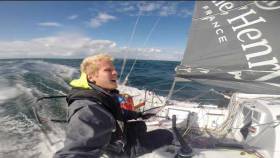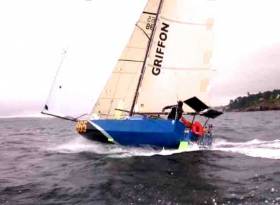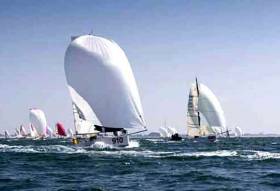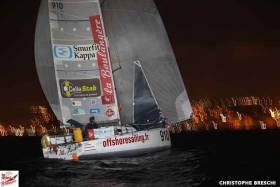Displaying items by tag: Tom Dolan
Tom Dolan Snatches Fourth at Finish of Mini-Transat 2017
In a final twist to the Mini-Transat 2017 saga this afternoon at Le Marin in Martinique, Ireland’s Tom Dolan came within 21 minutes of grabbing a podium place writes W M Nixon.
After Erwan Le Draoulec’s clear win this morning, a complete setback approaching the finish stymied second-placed Clarisse Cremer, and the three pursuing boats – Benoit Sineau, Tanguy Bouroullec, and Tom Dolan – swept by to finish with 48 minutes between them, Dolan filling fourth place overall. Meanwhile Cremer is still shown in the tracker as being 1.5 NM from the finish, and registering 0 knots, so we await further detail on what has happened.
But the fact that Dolan is now safely in turns attention to the combined overall total times for Legs 1 and 2, which is how the final placings are determined.
At 12th in Leg 1, Dolan was within striking distance of all ahead of him except Leg 1 winner Valentin Gautier, who was seven hours clear. But Gautier is still 41.7 miles from the finish of Leg 2, and making just 6.8 knots, with a chance of further speed loss as he comes in under the land. Much will hinge on how things pan out over the next six hours.
Tom Dolan Still Has Slim Thread of Hope for Mini-Transat Podium
With Production Class winner Erwan Le Draoulec finished early this morning in the Mini-Transat 2017 with a very clear lead, Irish solo sailor Tom Dolan’s many supporters at home and abroad maintain a slim hope that he might yet scrape through to a podium finish writes W M Nixon.
He has had a good night’s racing in fifth place, and has closed up to just two miles astern of Tanguy Boroullec in fourth and five miles behind Benoit Sineau in third, while Sineau still has 37.2 to race to the finish at Le Marin on Martinique.
However, Clarisse Cremer lying second well ahead has only 17 miles to go and is making 9.3 knots in a steady breeze, as is Sineau. But the two boats astern of him – Bouroullec and Dolan - are slightly slower at 8.9 for Bouroullec and 8.7 for Dolan.
Doubtless these speeds will pick up as they begin to enjoy the fresher breeze ahead. Yet with such even matching of speeds, the chances of position changes at this late stage are receding. But we live in hope. And with 25 miles clear back to sixth-placed Pierre Chedeville, Tom Dolan is at least reasonably sure of a fifth.
Tracker here
Mini-Transat: Tom Dolan Will Have All to Play for in Final Two Hundred Miles
Fortunes have waxed and waned as the 80 little boats in the Mini Transat Boulangere close towards the finish of the 2,000 mile transoceanic leg from Las Palmas in the Canaries - via a mandatory gate in the Cape Verde Islands - to St Marin in Martinique in the Caribbean writes W M Nixon.
Bowling along in the fluctuating east to northeast tradewinds, as expected the Prototype Division’s Ian Lipinski with the scow-bowed Griffon.fr has led the fleet overall to the line. He finished yesterday, and Proto runner-up Jorg Riechers is only slowly approaching the line in locally very light airs for his finish this morning.
It’s a result which gives Lipinski a remarkable double, as he won the Production Class in the previous staging of this biennial classic two years ago – it’s the first time in the 40 year history of the event that the double has been achieved.
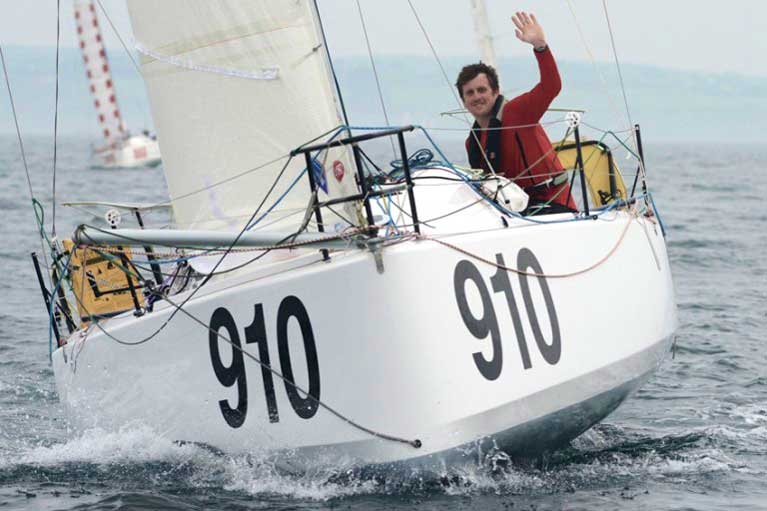 Tom Dolan, Ireland’s second-ever entrant in the Mini-Transat (Enda O Coineen was the first a long time ago), is facing a battle for fourth or perhaps third place in the Production Class in the final 200 miles of the Mini-Transat
Tom Dolan, Ireland’s second-ever entrant in the Mini-Transat (Enda O Coineen was the first a long time ago), is facing a battle for fourth or perhaps third place in the Production Class in the final 200 miles of the Mini-Transat
In this year’s Production Class, Ireland’s Tom Dolan has found himself entering the concluding two hundred miles in a four-way battle for the final position in the quartet which will fill the second, third, fourth and fifth places. However, “four way battle” is only a relative term imposed by the considerable distance being raced. This morning, twenty miles separate Clarisse Cremer in second from Dolan in fifth, as they have respectively 89.7 and 109.7 miles to the leader Erwan le Draoulec, who is in turn 145 miles from the finish.
Dolan has a good chance of improving to fourth as he is only 4 miles astern of Benoit Sineau currently in fourth, and the Irish sailor has marginally improved his position during the past four hours. But options for making major tactical gains are closing off as the finish is neared and the fleet’s tracks get closer together.
At the front of the Production fleet where the leaders are racing the Pogo 3, wunderkind Erwan Le Draoulec – he’s aged just 20 – is in a world of his own with those 145 miles still to sail. With nearly 90 miles clear of second-placed Cremer, his current speed of 7.7 knots is currently maintaining his lead. That said, as Jorg Riechers has been learning the hard way in recent hours, actually getting to the finish line off a Caribbean Island can sometimes be difficult for the final few miles. But nevertheless Le Draoulec has every reason for confidence.
Tracker here
Tom Dolan Fights for Mini-Transat Third in Volatile Weather Conditions
Ireland’s Tom Dolan held on to third place over the weekend as the Mini-Transat Production Class leaders closed into the final third of the Transoceanic leg, with the northeast tradewinds providing difficult sailing in increasingly volatile conditions writes W M Nixon.
But with different areas of the ocean temporarily experiencing better winds, his ranking this morning by been displaced by Tanguy Bouroullec well to the south, and currently logging 11.0 knots to put him up to third, while Benoit Sineau is lying fourth in a position slightly to the north of Dolan, and sailing at 9.0 knots.
Dolan himself is currently on just 8.5, but all are within striking distance of each other in terms of placings, and all have closed slightly on second-placed Clarisse Cremer. But the “Enfant Terrible” of the Mini-Transat Production fleet, 20-year Erwan Le Draoulec, sails serenely at 10 knots on well clear of everyone, and all of 90 miles ahead of Cremer – and he has just 511 miles to go.
Further ahead, Proto-type leader Ian Lipinski in the “super-scow” Griffon.fr is now in a race of his own. With only 268 miles to sail, he has the finish at St Marin in Martinique in striking distance, sailing at 11.7 knots with 90 miles in hand on second-placed Jorg Riechers in Lillienthal.
Race Tracker here
Tom Dolan is Third as Mini-Transat Sailors Race Towards the “Thousand-Miles-To-Finish” breakthrough
Tom Dolan has been having a good week in the Mini-Transat as he consolidates his position among the leading five writes W M Nixon. This morning, he’s in third place, having gained from his closest challenger Pierre Chedeville making what proved to be an unrewarding diversion to the southwards earlier in the week as the fleet tacks to lee in the prevailing east to northeast winds.
A fairly consistent favourable wind pattern has built up round the lower flank of the large Azores High Pressure System centred well to the north as the little boats put the turning gate at the Cape Verde Islands far astern. This has resulted in steady though not spectacular speeds as the large fleet make westing. That said, it tells us much about the calibre of the current range of Proto and Production boats in this, the 40th Anniversary Mini-Transat, that “steady though not spectacular speeds” have seen the Production boats around the 8 to 11 knot level, while the Prototypes, led by Ian Lipinski’s Griffon.fr, have been logging mostly 9 to 12 knots.
Lipinski yesterday went through the thousand-miles-to-go stage to the finish at Martinique as he continues to stride out at the front of the fleet, which has generally followed his strategy of searching for the firmer winds indicated to the north of the direct Cape Verde-Martinique route.
Clear in the lead in the Production Class is 20-year-old Erwan le Draoulec, currently on port gybe and closing again southwestwards towards the baseline at a speed of 9.8 knots. The overall placings – inevitably something of a guesstimate in a tacking-to-lee situation like this – show Le Draoulec as 49.8 miles ahead of second-placed Clarisse Cremer who is at 8.7 knots, while more or less directly astern and also now on port is Tom Dolan, making a better 10.8 knots, but he’s 96 miles behind Le Draoulec.
However, he currently has an indicated distance cushion of 11 miles between himself and closest contender, 4th placed Benoit Sineau, while his challenger early in the week, Pierre Chedeville, is fifth and indicated as 34 miles behind Dolan. So we can allow ourselves to feel reasonably assured that Tom Dolan is lying third as he races on towards the weekend, with the significant passing of the thousand-miles-to-the-finish marker being the next item on the agenda for the Meath sailor and his Production Class rivals. Leader Le Draoulac now has only 112 miles to go to this key psychological staging post.
Race tracker here
Tom Dolan Lies Sixth as Mini-Transat Fleet Leaders Reach Gate at Cape Verde Islands
Ireland’s solo sailor Tom Dolan has been finding form and much-improved placings among the leaders in the Mini-Transat 2017 as the front runners approach the mandatory course gate, the channel between Santo Antao and Sao Vicente, the most westerly islands of the Cape Verde archipelago writes W M Nixon.
Since Wednesday’s start from Las Palmas in the Canaries, Dolan has seen his position in the 55-trong fleet steadily rising. His strategy of being among the first to get determinedly over to the stronger northeast winds closer to the African coast provided a zero to hero scenario, as he was briefly 54th, but was soon moving rapidly up through the rankings in classic Dolan style.
At one stage yesterday he was showing as being in fifth, but placings among some sections of the leading group are very closely contested, and this morning he is sixth, closing towards the channel between the islands at 9.7 knots.
However, current leaders Tanguy Bourollec (1st), Erwan le Draoulec (2nd) and Clarisse Cremer (3rd) are likely to go through the Cape Verdes in that order. But with a wind shadow indicated to the leeward of Santo Antao on its southwest side, the decision of how soon to make the turn westward for Martinique in the Caribbean could be a tricky one.
Some boats further down the fleet have already indicated their intention to go into the port of Mindao in the Cape Verdes for essential repairs, and if they take that pit stop option, they’re obliged to stay for 12 hours, making for a real divide in the fleet.
So far, Dolan has given no hint of requiring to do this, but one or two of those who need to make the stop will not reveal it until the last minute. However, for Tom Dolan, the Atlantic crossing itself is ultimately what it’s all about, and he is enthusiastic about the possibilities of making more gains as the fleet begin the 2000-mile “real” Mini-Transat from San Antao for St Marin in Martinique.
As a rookie in the 2015 race, Tom Dolan was a respectable 22nd in the Production Boat Class with fleet numbers comparable to this year. But with his new Pogo 3 IRL 910 racing this 2017 event, he is expecting much better of himself, and currently things are looking good.
Race tracker here
Ireland’s solo sailor Tom Dolan moved up to 15th place over-night as the fleet in Mini-Transat continues to hold closer to the African coast in search of stronger northeast breezes writes W M Nixon. However, the decision to make the break to start to get nearer the base line to the turning point at Santo Antao in the Cape Verde Islands will rise steadily up on today’s agenda, and already current leader Remi Aubron is on starboard tack, and well over to the westward of the rest of the fleet.
But he has seen his speed go down to 8 knots, while Dolan and his sparring partner Pierre Chedeville, still on port tack over towards Africa, are on 11 and 10 knots respectively. Between them. but likewise still on port and on speeds comparable with Dolan and Chedeville, are the most consistent performers Tanguy Bouroullec, Clarisse Cremer and Erwan Le Draoulec, currently rated as 2nd, 3rd and 4th on the leaderboard.
Race tracker here
Mini-Transat – Tom Dolan Gains Ground by Holding Towards African Coast
In the Transatlantic stage of the La Boulangerie Mini-Transat 2017, which started yesterday from Las Palmas in Gran Canaria, solo sailor Tom Dolan and his rival/friend Pierre Chedeville have chosen to break from the fleet and hold well to the east, seeking stronger favourable winds running along the African coast writes W M Nixon.
This became a viable option when the organisers added 200 miles to the 1700-mile Stage 2 to the Caribbean, routing the fleet on a much more southerly route through the Cape Verde islands, in order to avoid a late season storm in mid-Atlantic on the direct route to Martinique.
Yesterday evening Dolan was taking his medicine as his tactic initially saw him slip back as far as 55th in fleet. But this morning both he and Chedeville are making hay at speeds between 9 and 11 knots with Chedeville slightly ahead in 22nd place and rising in the rankings, while Dolan has shot up to 26th.
The tactic is a long-term ploy, and its effectiveness (or otherwise) will need another day or two of racing for full assessment. But it certainly adds a sporting element to an event in which relatively close-fleet racing was the norm in the first stage from La Rochelle to Las Palmas.
Current leader is Tanguy Bouroullec, while this year’s most consistent star Erwan Le Draoulec is third and the Stage 1 winner Valentin Gautier is seventh. But they are well offshore from Africa, and currently sailing a couple of knots slower than Dolan and Chedeville.
Tracker chart here
Defiant Tom Dolan Still Targeting Podium as Mini Transat Resumes
Irish solo sailor Tom Dolan has vowed to bounce back after a disappointing start to his bid to reach the podium of the Mini Transat when the second leg begins on November 1.
The 30-year-old from Kells, County Meath, admits he was "gutted" to finish the first stage of the iconic solo race in 12th place in the 56-strong 'série' division for production boats.
One of the pre-race favourites after a strong 2017 season, Dolan led the fleet out of La Rochelle, France, until realising he had made a course error and had to turn back.
The mistake relegated him to the back of the fleet but he managed to fight his way back to finish Leg 1 in Las Palmas, Gran Canaria, just outside the top ten after just shy of 11 days at sea.
Tired and frustrated by the result, Dolan flew home to Ireland to rest and recharge at his parents' house.
With the start of the second stage - a 2,700 nautical mile race across the Atlantic to Le Marin in Martinique - looming, Dolan said he is ready to put leg one behind him and pull out all the stops for leg two.
“It was heartbreaking having to sail back under spinnaker towards La Rochelle when I realised I'd made a mistake a few hours after the start of leg one,” he said.
“I managed to claw my back back to twelfth but it wasn't the result I was after. I was gutted.
“I decided to go home for a bit to rest up. It was my first week off in months and it did me well.
“Now I'm looking forward to getting going again. The run-up to the start of leg one in La Rochelle were stressful but going into the second leg will be much easier without so many commitments. It'll be nice to concentrate solely on the sailing.”
Despite Dolan's disappointment his goal of a podium finish is still very much doable – the Mini Transat is scored on cumulative time, and he is currently just seven hours behind leg one winner Valentin Gautier.
Unlike in the first leg where the fleet sailed a fairly straight line south west to Las Palmas, the second stage across the Atlantic will provide plenty more tactical options.
“I need to make up seven hours on first place and five hours on second - it's nothing really over a 2,700-mile leg,” Dolan said.
“Because the next stage is across the Atlantic there will be much bigger lateral splits between boats. Anything can happen. One wind shift of a few degrees could see that time wiped off.”
The forecast for the start of leg two, beginning on Wednesday, is for stable North Easterly winds of 12-14 knots – perfect conditions to propel the fleet out into the Atlantic.
The stage is expected to take around two weeks to complete.
Follow Dolan's progress in the race here. Tom races in the Série Fleet. His boat is 910 Offshoresailing.fr
As the tension builds for Ireland's Tom Dolan, the Mini Transat fleet have had a late change of course ahead of tomorrow's Transatlantic start from Gran Canaria.
Midway between the Bahamas and the Azores, a tropical wave is taking shape as an active storm formation looms say organisers. For the time being, the associated minimum low pressure is not likely to prove dangerous, however the water temperature, which is exceptionally warm for this time of year, is conditioned by a high degree of instability. As such, ultimately, the formation of a tropical storm is a plausible hypothesis.
Grouped around the tables in the racers’ zone in the Vela Latina marina, the solo sailors were all talking about it. As they awaited a decision from Race Management, everyone was guessing the possible outcomes. Indeed, this morning, the routing clearly favoured a route a long way north of the direct course, but one that is potentially on a collision course with the tropical storm in question. Various scenarios were being mooted as to how likely it was that the tropical wave would transform into a deep depression, or even form into a hurricane. 20% probability is an acceptable hypothesis according to some, whilst other reckoned it was still too high.
Detour via Cape Verde
Race Management has since made its decision. Wishing to avoid taking the risk of sending the fleet of 6.50m boats into winds in excess of 45 knots and wild seas, Denis Hugues, in agreement with the organiser, has decided to create a compulsory gate between the islands of Santo Antao, to the north and Sao Vicente to the south. In terms of distance, this equates to a detour of around 200 miles in relation to the direct route, or one long extra day to make Martinique. On the upside comes the guarantee that everyone will be sufficiently far away from the potential centre of the tropical low. In any case, the passage along the channel between the two islands may herald further measures to be imposed upon the Mini sailors should the weather situation deteriorate.
A change of strategy and tone
Of course, the passage via the Cape Verde islands changes the strategic tone somewhat. Some sailors were hoping for a wide open playing field, but now they will be forced into some more refined navigation, where the timing of the gybes is sure to count a lot more than any choices about major options. Indeed, the racers will have to really be on their game to find the right wind angles and be opportunistic on the trade wind route, which is seldom steady. Those who feared they would be playing trains will feel let down. That said, who would choose to hit the road in a car whose brakes had a 20% chance of failing?





























